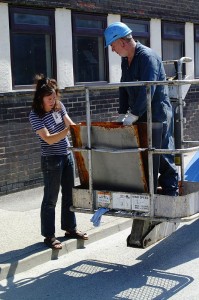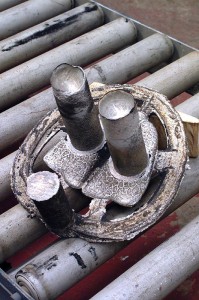Thursday October 25th What goes on at the bottom of a Pit
Thought how the Archive, how to deal with it, how to trawl through, what you do with findings again is a creative act.The fact its opened me up to thinking about so many things, making connections, looking at work I’ve done afresh etc, has all been so important so far.
Today I looked at some periodical articles from the time in an attempt to contextualise the apg within and find out how it was perceived.
TGA 20042/5/2/1 art and artists magazine Dec 1971 Volume 6, Number 9, Issue 1969. Article “subversion and APG’ by Peter Fuller.
This was quite a critical article…..”Where APG fails is in its absence of overall political vision. Its negative side is its naive idealism, its belief that the oppressive advance of materialistic capitalism can actually be stemmed and transformed through the correct response of the masses to the activities or artists strategically placed in the larger commercial organisations…. Industry could accept the artists, because, again in APG’s own words, it “is now on the point of realising that it could accommodate an individual who is:-
-independent of the commercial premise
-independent of the industrial argument
-engaged on an activity that is undefined in its own terms so that he is able to “speak” to all levels.”
….Latham says there is not much difference between Castro and Nixon… he might know what it is like inside the National Coal Board’s Executive Suite, but he has no idea what goes on at the bottom of a pit.”
8 questions posed to apg artists on or about to go on placements in industry in 1971 –COULD POSE THESE AGAIN TO OUR CURRENT UNIVERSITY OF SALFORD STUDENTS AS AN EXPERIMENT? from 41 years ago.What has changed?
1. How would you define the difference between an APG approach and the more conventional idea of an artist in residence?
2. Is it important to you to produce something at the end of your project which will have a lasting effect?
3. Where do you see the meeting-point between your art work and the community at large?
4. What can the artist, as opposed to any other kind of worker, contribute to society?
5. How far can your work on this particular project be applied to other, perhaps non-urban, social contexts/
6. What is your political motivation?
7. Do you think you can maintain your independence while the project is being carried out?
8. Do you have a satisfactory definition of ‘knowledge’ in your work?
In the evening, I met up with Dr Rachel Garfield, an Artist working mainly in video, who used to work on our staff team on Visual Arts at University of Salford – Rachel is now Head of Postgraduate Studies in the Fine Art Department at University of Reading.
http://www.rachelgarfield.com/
We went to an Opening at England & Co, a gallery just off Oxford Street, where I met the gallery director, Jane England .The gallery specialises in video, film and photography, and was showing work by David Hall, who, coincidentally, was one of the APG artists.
http://www.englandgallery.com/


